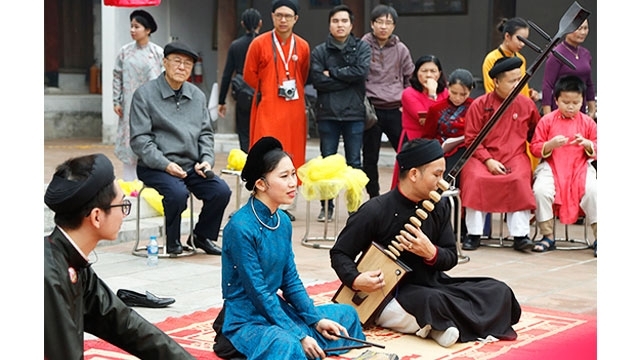Vocalist Nguyen Kim Ngoc, who is working at the Vietnamese Institute for Musicology, is one of young people dedicating themselves to the preservation and promotion of this uniquely traditional art form.
She granted an interview to the Thoi Nay (Present Times) Publication of Nhan Dan (People) Newspaper.
Q: Did your father, the late artisan Nguyen Kim Sinh, influence your decision to associate with the art of Ca Tru?
A: My father brought me into the musical world, although it was a bit late. For me, he will always be the greatest teacher. His beautiful melodies nourished my soul so that I could enhance my own achievements today.
My dad did not orient me toward singing Ca Tru but he helped me recognise the uniqueness of this art form. He greatly admired the voice of artisan Quach Thi Ho and answered my naive questions when I did not understand the sophistication of the vocalists.
Later, I started learning Ca Tru from his student, vocalist Pham Thi Hue. I remember whenever I learned a new musical form or melody, I used to record it to listen to his objective comments. It was very strange that he only paid attention to the method of singing and emotion but didn’t care about who was singing. I received very valuable comments from my fastidious teacher and audience which helped me gradually collect the necessary knowledge.
Q: How do you maintain your music career? Does your work at the Vietnamese Institute for Musicology help your artistic activity?
A: I got involved with the Institute after I studied at the Vietnam National Academy of Music. The Institute gave me a predestined oath as I became a student of late artisan Nguyen Thi Chuc.
In the past, Ca Tru was only passed down to younger generations in families; therefore, it was very difficult to convince artisans to accept students from outside. Fortunately, in 2012, the Institute invited artisans Nguyen Thi Chuc and Nguyen Phu De to teach at a short training course. I joined the course and was chosen as a performer at the closing ceremony. After the performance, I asked artisan Chuc to give me feedback about my melodies. I felt her satisfaction about what I had learned from the training course. After that, she accepted me as her student, so I studied Ca Tru in her hometown (Ngai Cau village in Hoai Duc District, Hanoi) for two years.
I am now a member of Phu Tri Ca Tru Club. I am personally very fortunate to sing regularly at the Kim Ngan Temple in Hanoi’s Old Quarter and Cao Sơn Tea & Coffee in Dong Da District. It has been wonderful as I have met many audiences who loved Ca Tru so much. I feel very happy!
Q: How do you think about the artisans of the same age as there have not been many artisans of older generations?
A: I think that current vocalists are really respectable and a little brave because there are not many events for Ca Tru arts, except national, provincial and municipal festivals. In addition, artisans from the golden age are no longer living. Particularly with Ca Tru, young people must learn directly from artisans so that they can absorb the essentials of this art form. This is a disadvantage for young artists, which has made the quality of Ca Tru singing not as good as that of the previous generation.
Q: In your opinion, what measures should be taken to preserve and promote the values of the traditional art form?
A: I did not dare to dream that Ca Tru will flourish because society has changed. I think that in order to preserve and promote this genre, I should train harder so that each beat and melody can express the spirit and style of previous artisans. In addition, Ca Tru is not accessible to the public, so we have to learn ways to enjoy, sing and play the relevant instruments in order to understand and love it. That means training the listeners is also as necessary as the training of vocalists and lute players.
Q: Does your daughter have an aptitude for this art form?
A: Although she is very young and playful, she has a good voice and ability to absorb. I was also surprised that she could learn the basic framework of phach (small wooden sticks beaten on a small bamboo box serving as percussion) for just a short time and perform “hat noi” (a musical form or melody) at the second Hanoi Ca Tru Young Talent Festival in November 2019. I hope that she will raise her awareness of studying Ca Tru.
Q: What do you want to say to young people who are dedicating to Ca Tru genre?
A: If you really love Ca Tru, you should learn seriously, fully and responsibly so as not to shame your ancestors. Only if you have a true love for Ca Tru will you feel its beauty.
Thank you very much for your interview!




